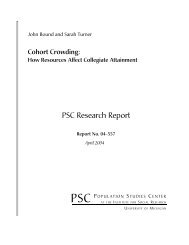Population Ageing and the Well-Being of Older Persons in Thailand ...
Population Ageing and the Well-Being of Older Persons in Thailand ...
Population Ageing and the Well-Being of Older Persons in Thailand ...
Create successful ePaper yourself
Turn your PDF publications into a flip-book with our unique Google optimized e-Paper software.
Section 3: Demographic, Social <strong>and</strong> Economic Pr<strong>of</strong>ile<br />
<strong>in</strong> recent years, <strong>the</strong> gender gap reversed <strong>and</strong> now girls<br />
atta<strong>in</strong> more formal school<strong>in</strong>g than boys <strong>in</strong> Thail<strong>and</strong><br />
(Knodel 1997).<br />
Considerable attention has been devoted to <strong>the</strong><br />
potential impact on <strong>the</strong> well-be<strong>in</strong>g <strong>of</strong> <strong>the</strong> future<br />
elderly from social <strong>and</strong> economic change associated<br />
with development <strong>in</strong> Thail<strong>and</strong> <strong>and</strong> <strong>the</strong> develop<strong>in</strong>g<br />
world generally (Kanchanachitra et al. 2007). Less<br />
widely recognized is that, through <strong>the</strong> process <strong>of</strong><br />
cohort succession, <strong>the</strong> elderly <strong>of</strong> <strong>the</strong> future who will<br />
experience <strong>the</strong>se impacts will differ considerably <strong>in</strong><br />
<strong>the</strong>ir characteristics from <strong>the</strong> elderly <strong>of</strong> today.<br />
Cohort succession refers to <strong>the</strong> replacement <strong>of</strong><br />
persons mak<strong>in</strong>g up any particular age group <strong>in</strong> a given<br />
year by persons currently younger than <strong>the</strong>m as time<br />
passes. Successive cohorts differ from each o<strong>the</strong>r not<br />
only <strong>in</strong> numerical size, but also <strong>in</strong> <strong>the</strong>ir socioeconomic<br />
<strong>and</strong> demographic composition. Thus <strong>the</strong><br />
characteristics <strong>of</strong> age groups change as time passes.<br />
S<strong>in</strong>ce education is largely “fixed” at an earlier stages<br />
<strong>of</strong> life, project<strong>in</strong>g <strong>the</strong> chang<strong>in</strong>g educational<br />
composition <strong>of</strong> persons who will be <strong>in</strong> <strong>the</strong> elderly age<br />
range <strong>in</strong> <strong>the</strong> future based on <strong>in</strong>formation for <strong>the</strong><br />
current adult population below <strong>the</strong> elderly ages is a<br />
relatively straightforward exercise.<br />
Anticipat<strong>in</strong>g changes <strong>in</strong> <strong>the</strong> educational levels <strong>of</strong> <strong>the</strong><br />
older population is useful for a number <strong>of</strong> reasons.<br />
Education <strong>in</strong>fluences employment opportunities <strong>and</strong><br />
thus f<strong>in</strong>ancial status later <strong>in</strong> life. Literacy provides<br />
much greater access to <strong>in</strong>formation. Better education<br />
enables older persons to deal more effectively with<br />
government agencies <strong>and</strong> health services. Moreover,<br />
as recent analyses have shown, higher levels <strong>of</strong><br />
education are associated with better health status<br />
<strong>in</strong> Thail<strong>and</strong> as elsewhere (Zimmer <strong>and</strong> Amornsirisomboon<br />
2001).<br />
A recent study has projected <strong>the</strong> educational<br />
distribution for <strong>the</strong> population age 65 <strong>and</strong> over for a<br />
number <strong>of</strong> develop<strong>in</strong>g countries <strong>in</strong>clud<strong>in</strong>g Thail<strong>and</strong><br />
us<strong>in</strong>g census data from 2000 (Hermal<strong>in</strong>, Ofstedal &<br />
Tesfai 2007). Table 3.3 shows educational<br />
characteristics <strong>of</strong> Thais age 65 <strong>and</strong> over by gender as<br />
projected from 2000 through 2045. Two <strong>in</strong>dicators<br />
are provided. The first shows <strong>the</strong> per cent who have<br />
no more than primary education <strong>in</strong>clud<strong>in</strong>g those<br />
lack<strong>in</strong>g any formal education. The second shows <strong>the</strong><br />
per cent who have at least some upper secondary or<br />
higher education. In general, men have more<br />
education than women. This is reflected by <strong>the</strong> fact<br />
that, through <strong>the</strong> entire period covered by <strong>the</strong><br />
projection, higher percentages <strong>of</strong> older women are<br />
characterized by no more than a primary education<br />
<strong>and</strong> a lower percentage by upper secondary or higher<br />
education. Overall, <strong>the</strong> educational pr<strong>of</strong>ile <strong>of</strong> <strong>the</strong> older<br />
population <strong>in</strong> Thail<strong>and</strong> will improve considerably by<br />
2045. Still, for <strong>the</strong> next few decades, a large majority<br />
<strong>of</strong> both older men <strong>and</strong> women will have had at most<br />
only a primary level education <strong>and</strong> just a small<br />
m<strong>in</strong>ority will have atta<strong>in</strong>ed upper secondary or higher<br />
level education. By 2030, however, <strong>the</strong> educational<br />
composition <strong>of</strong> <strong>the</strong> population 65 <strong>and</strong> older starts to<br />
show significant improvements reflect<strong>in</strong>g <strong>the</strong> major<br />
expansion <strong>of</strong> secondary education <strong>in</strong> Thail<strong>and</strong> that<br />
began around 1990 (Knodel 1997).<br />
18















